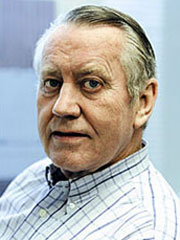Giving more than the “Giving Pledge”
Resource type: News
GlobalPost | [ View Original Source (opens in new window) ]
By Conor O’Clery
Editor’s note: Conor O’Clery is the author of the biography of Chuck Feeney, “The Billionaire Who Wasn’t.”
|
Chuck Feeney |
DUBLIN, Ireland — Chuck Feeney, one of the world’s major philanthropists, has some reservations about The Giving Pledge, an effort by Warren Buffett and Bill and Melinda Gates to persuade wealthy Americans to commit at least half their fortunes to charity.
“I support it, but it doesn’t go far enough,” said Feeney, over a cappuccino at the Boulevard Cafe in Dublin on a recent visit to Ireland.
The former duty-free billionaire, who is the largest donor to a number of American universities, including Stanford and Cornell, and the biggest single philanthropist in Vietnam, Australia and Ireland, is unique among givers in that he has already divested himself of all his vast accumulated wealth.
The famously-frugal Feeney, 79, was wearing his usual cheap plastic watch and his one pair of shoes. He explained why he thinks The Giving Pledge falls short of the philosophy of Giving While Living, which he espouses.
“Giving While Living makes it clear, The Giving Pledge doesn’t,” he said, in a typically cryptic manner.
Feeney then pushed across the cafe table a few lines he had drafted in response to the Giving Pledge: “In May 2009 I attended the first gathering initiated by the Gateses and Buffet to elicit discussion among a small group of philanthropists about how to encourage greater giving among those with huge wealth,” he noted, referring to the now celebrated private dinner in New York attended by a dozen billionaires including New York Mayor Michael Bloomberg, hotel heir Barron Hilton and George Lucas, of “Star Wars” fame.
“I was asked to participate in The Giving Pledge in conjunction with its public roll-out,” Feeney’s response continued. “After thinking it over, I declined. This is primarily because, having taken this step 25 years ago, I don’t believe it is appropriate for me to join formally. Nevertheless I support the initiative, with which some 35 wealthy individuals and couples are now associated, and I remain open-minded as to how I might contribute to its further development and the ensuing process.”
Feeney, born into a white-collar Irish-American family in New Jersey, has already taken giving to its highest level. In 1984, after becoming one of the wealthiest men in the world, he assigned all his businesses, shareholdings and other assets to his foundation, today known as The Atlantic Philanthropies, to be distributed anonymously to worthy causes. His act made philanthropic history and only became known in recent years when he abandoned his lifelong policy of anonymity so his story might become a model for other enormously rich people.
Feeney’s example helped influence Bill Gates: The founder of Microsoft acknowledged to Charlie Rose on PBS that he was inspired by Feeney’s “phenomenal story.”
The former billionaire wondered aloud whether the Giving Pledges would translate easily into productive philanthropy, and about the probable push-back from spouses and other family members over the signing away of half the family silver by well-meaning people of wealth “who don’t realize the inherent problems.” He said he suspects little is actually happening since the wealthy individuals made their public pledges.
The initiative prompted him to reflect on his own historic decision to spend his mature years seeking out and funding good causes with his money, mainly to support medical research, hospitals and universities, and for his foundation to commit all its remaining funds by 2016. (It will by then have provided an estimated $2 billion more in grants on top of $5 billion already donated.)
Feeney believes that it was in fact “a sensible means for directing to good purpose, in a timely manner, a large and increasing wealth that well exceeded my, and my family’s, lifetime needs, and which I believe would have become problematic.” Instead, the process of giving to good causes has been “a rich source of joy and satisfaction for me and for my family as well,” he said. Feeney has four daughters and a son.
His message to other billionaires now is, “If you try it, you might like it!” He underlines, however, the importance of strong personal engagement and of combining a passionate interest in helping others with informed risk-taking, the participation of experts and specialists, and an appreciation of the challenges and complexities of philanthropy.
Feeney’s giving has affected positively the lives of millions on the planet, mainly through adherence to the core of his philanthropic approach: making available the seed money and inspiration for “bricks and mortar” ventures around the globe that will provide research facilities and educational opportunities for people well into the future.
At his insistence his name does not appear on any building he has funded, though he has no problem with the practice by some donors of buying naming rights. “I don’t think it matters who gets the credit, as long as it is done,” he said.
Feeney still travels around the world seeking opportunities for his giving. One incident I witnessed in Vietnam, when I was researching his biography, was characteristic. After a hospital director in Da Nang thanked him profusely for funding an engineering and diagnostic center — a need that Feeney had identified after a number of visits and consultations — the former billionaire replied, “The truth is, all the credit for this is yours. You are the people that do good things with the money.”
